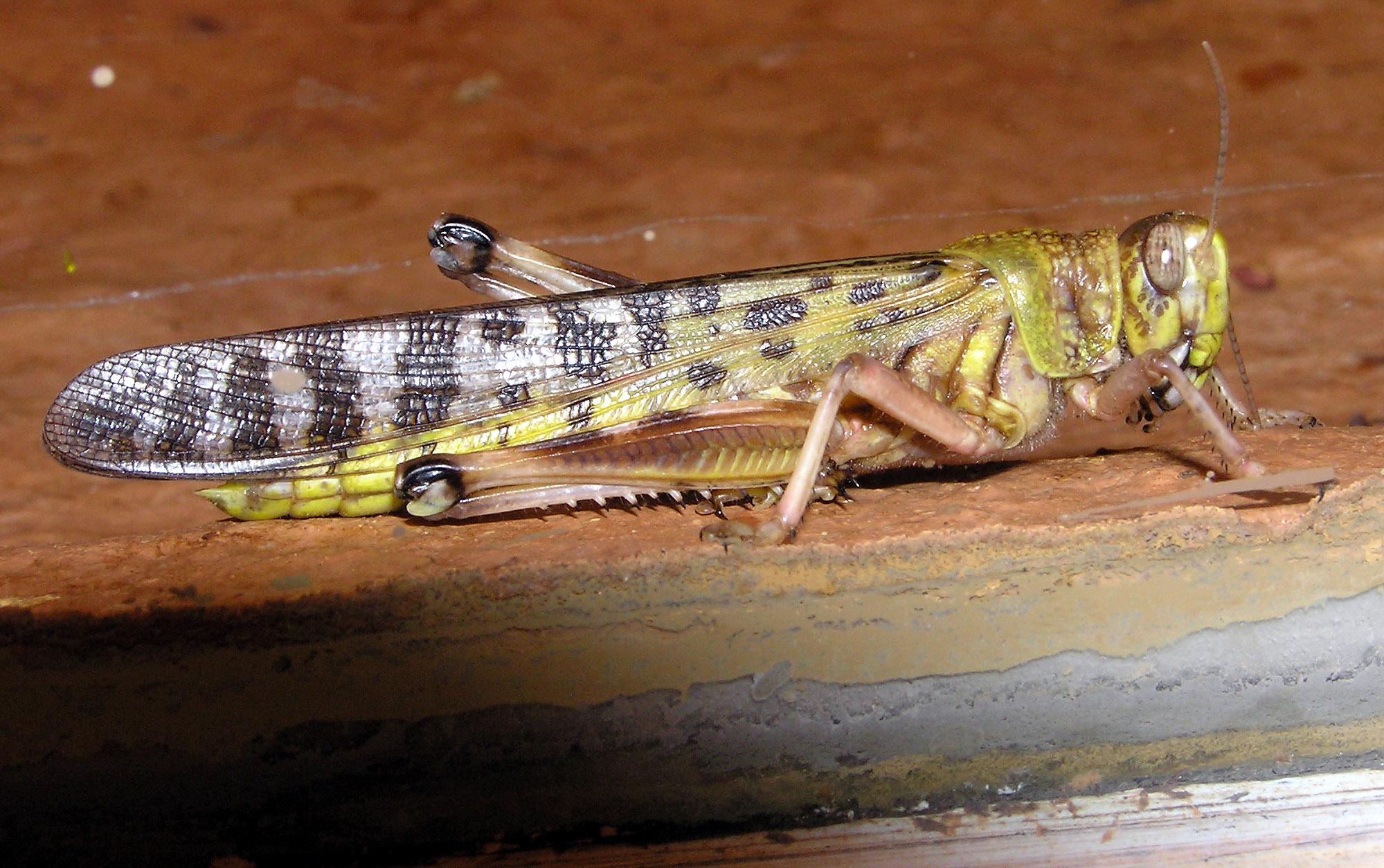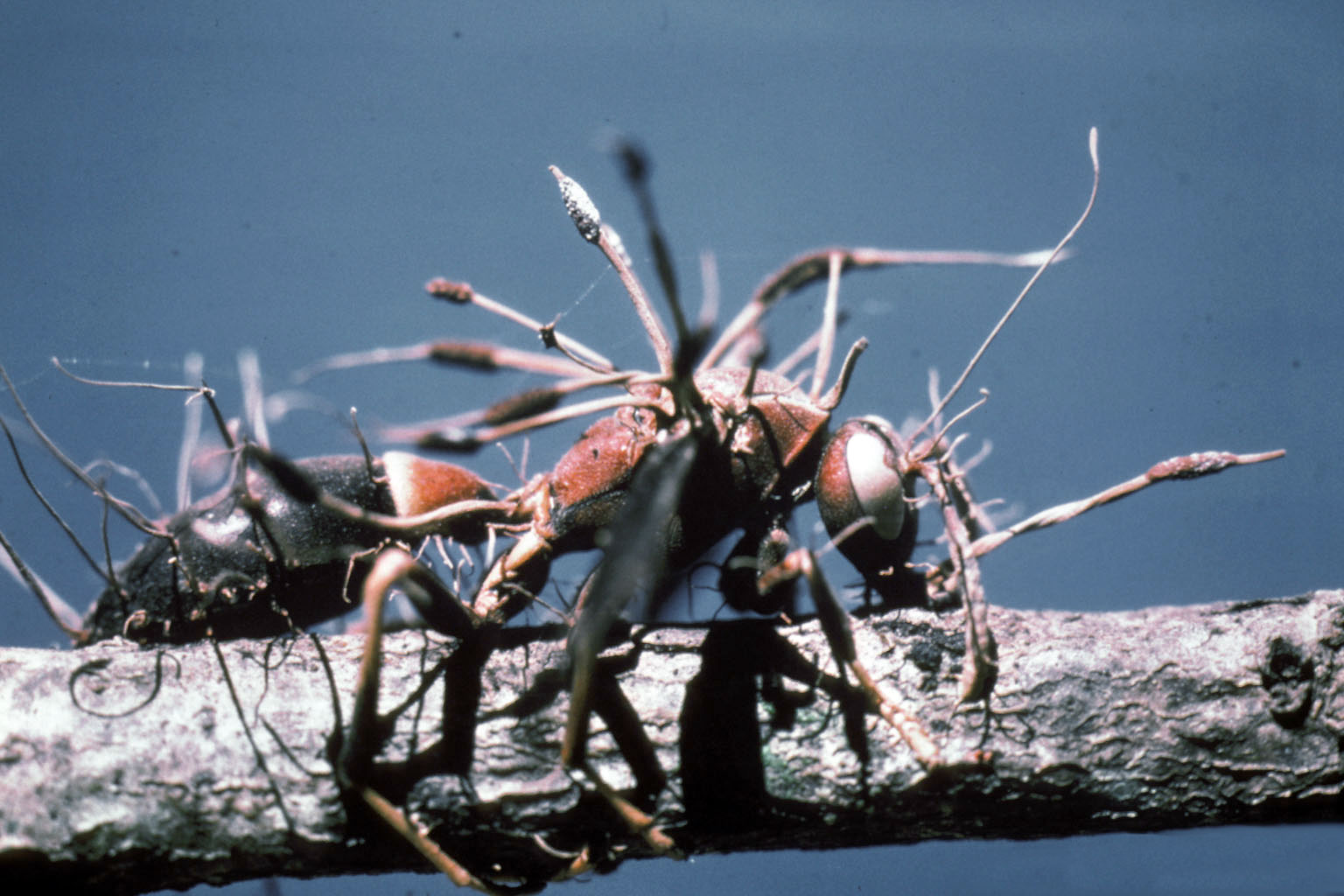|
Hieroglyphus Daganensis
The African rice grasshopper, ''Hieroglyphus daganensis'' is a medium-sized grasshopper species found in the Sahel region. Although not called a locust in English, this species shows gregarious behaviour and some morphological change (phase polymorphism) on crowding and may become a moderately important pest species for small-holder farmers in the region. Description and biology Adults The overall colour of adult insects is usually green, with a finely dotted shiny integument. Antennae are longer than the head and pronotum together. The pronotum is cylindrical, with three deep and wide sulci (grooves) crossing the dorsum. Hoppers Rice grasshopper nymphs in Mali, showing darkened coloration (on right) after crowding The colour of immature insects may vary depending on their phase (illustrated right) during a particularly fertile year, dense populations of ''H. daganensis'' showed a distinct blackening in certain areas of cuticle. Outbreaks and control Outbreaks are frequent ... [...More Info...] [...Related Items...] OR: [Wikipedia] [Google] [Baidu] |
Hermann August Krauss
Hermann August Krauss (1 August 1848 – 21 April 1939) was an Austrian entomologist who specialised in Orthoptera and Dermaptera. Krauss was a physician. His collection is in the Naturhistorisches Museum in Vienna. Selected publications *1877. Orthopteren vom Senegal. ''Anzeiger der Kaiserlichen Akademie der Wissenschaften. Mathematisch-Naturwissenschaftliche Klasse, Wien'', 14, no. xvi : 141-145. *1878. Orthopteren vom Senegal gesammelt von Dr. Frantz Steindachner. ''Sitzungsberichte der Kaiserlichen Akademie der Wissenschaften. Mathematisch-Naturwissenschaftliche Klasse, Wien'', (incorrectly dated 1877), 76 (1) : 29-63, 2 pl. *1890. Erklärung der Orthopteren-Tafeln J. C. Savigny’s in der "Description de l’Égypte". Aus der Literatur zusammengestellt und mit Bemerkungen Versehen. ''Verhandlungen der zoologisch-botanischen Gesellschaft in Wien'', 40 : 227-272. *1891. Beitrag zur Kenntniss westafrikanischer Orthopteren. 2. Orthopteren der Guinea-Inseln São Thomé und Rola ... [...More Info...] [...Related Items...] OR: [Wikipedia] [Google] [Baidu] |
Mali
Mali (; ), officially the Republic of Mali,, , ff, 𞤈𞤫𞤲𞥆𞤣𞤢𞥄𞤲𞤣𞤭 𞤃𞤢𞥄𞤤𞤭, Renndaandi Maali, italics=no, ar, جمهورية مالي, Jumhūriyyāt Mālī is a landlocked country in West Africa. Mali is the eighth-largest country in Africa, with an area of over . The population of Mali is million. 67% of its population was estimated to be under the age of 25 in 2017. Its capital and largest city is Bamako. The sovereign state of Mali consists of eight regions and its borders on the north reach deep into the middle of the Sahara Desert. The country's southern part is in the Sudanian savanna, where the majority of inhabitants live, and both the Niger and Senegal rivers pass through. The country's economy centres on agriculture and mining. One of Mali's most prominent natural resources is gold, and the country is the third largest producer of gold on the African continent. It also exports salt. Present-day Mali was once part of t ... [...More Info...] [...Related Items...] OR: [Wikipedia] [Google] [Baidu] |
Insects Described In 1877
Insects (from Latin ') are pancrustacean hexapod invertebrates of the class Insecta. They are the largest group within the arthropod phylum. Insects have a chitinous exoskeleton, a three-part body (head, thorax and abdomen), three pairs of jointed legs, compound eyes and one pair of antennae. Their blood is not totally contained in vessels; some circulates in an open cavity known as the haemocoel. Insects are the most diverse group of animals; they include more than a million described species and represent more than half of all known living organisms. The total number of extant species is estimated at between six and ten million; In: potentially over 90% of the animal life forms on Earth are insects. Insects may be found in nearly all environments, although only a small number of species reside in the oceans, which are dominated by another arthropod group, crustaceans, which recent research has indicated insects are nested within. Nearly all insects hatch from eggs. Insect ... [...More Info...] [...Related Items...] OR: [Wikipedia] [Google] [Baidu] |
Acrididae
The AcrididaeMacLeay WS (1821) ''Horae Entomologicae or Essays on the Annulose Animals'' 2 are the predominant family of grasshoppers, comprising some 10,000 of the 11,000 species of the entire suborder Caelifera. The Acrididae are best known because all locusts (swarming grasshoppers) are of the Acrididae. The subfamily Oedipodinae is sometimes classified as a distinct family Oedipodidae in the superfamily Acridoidea. Acrididae grasshoppers are characterized by relatively short and stout antennae, and tympana on the side of the first abdominal segment. Subfamilies The ''Orthoptera Species File'' (September 2021) lists the following subfamilies of Acrididae. The numbers of genera and species are approximate and may change over time. # Acridinae MacLeay, 1821 (140 genera, 470 species), Worldwide: temperate and tropical # Calliptaminae Jacobson, 1905 (12 genera, 90 species), Africa, Europe, Asia # Caryandinae Yin & Liu, 1987 (3 genera, 100 species), Africa, Asia ## ''C ... [...More Info...] [...Related Items...] OR: [Wikipedia] [Google] [Baidu] |
Dogon People
The Dogon are an ethnic group indigenous to the central plateau region of Mali, in West Africa, south of the Niger River, Niger bend, near the city of Bandiagara, and in Burkina Faso. The population numbers between 400,000 and 800,000. They speak the Dogon languages, which are considered to constitute an independent branch of the Niger–Congo language family, meaning that they are not closely related to any other languages. The Dogon are best known for Dogon religion, their religious traditions, their mask dances, wooden sculpture, and their architecture. Since the twentieth century, there have been significant changes in the social organisation, material culture and beliefs of the Dogon, in part because Dogon country is one of Mali's major tourist attractions. Geography and history The principal Dogon area is bisected by the Bandiagara Escarpment, a sandstone cliff of up to high, stretching about 150 km (90 miles). To the southeast of the cliff, the sandy Séno-Gond ... [...More Info...] [...Related Items...] OR: [Wikipedia] [Google] [Baidu] |
LUBILOSA
LUBILOSA was the name of a research programme that aimed at developing a biological alternative to the chemical control of locusts. This name is an acronym of the French title of the programme: Lutte Biologique contre les Locustes et les Sauteriaux (biological control of locusts and grasshoppers). During its 13-year life (November 1989 to December 2002), the programme identified an isolate of an entomopathogenic fungus belonging to the genus ''Metarhizium'' and virulent to locusts, and went through all the necessary steps to develop the commercial biopesticide product ''Green Muscle'' based on its spores. Collaborators The programme was conceived by Chris Prior and David Greathead of the International Institute of Biological Control (IIBC), a former research institute of CAB International that was based at Silwood Park in the UK at that time. IIBC requested and obtained the collaboration of the former Biological Control Centre for Africa in Cotonou, Benin, that was owned and ... [...More Info...] [...Related Items...] OR: [Wikipedia] [Google] [Baidu] |
Desert Locust
The desert locust (''Schistocerca gregaria'') is a species of locust, a periodically swarming, short-horned grasshopper in the family Acrididae. They are found primarily in the deserts and dry areas of northern and eastern Africa, Arabia, and southwest Asia. During population surge years, they may extend north into parts of western Spain and southern Italy, south into Eastern Africa, and east in northern India. The desert locust shows periodic changes in its body form and can change in response to environmental conditions, over several generations, from a solitary, shorter-winged, highly fecund, non-migratory form to a gregarious, long-winged, and migratory phase in which they may travel long distances into new areas. In some years, they may thus form locust plagues, invading new areas, where they may consume all vegetation including crops, and at other times, they may live unnoticed in small numbers. During plague years, desert locusts can cause widespread damage to crops, as th ... [...More Info...] [...Related Items...] OR: [Wikipedia] [Google] [Baidu] |
Metarhizium Acridum
''Metarhizium acridum'' is the new name given to a group of fungal isolates that are known to be virulent and specific to the Acrididea (grasshoppers). Previously, this species has had variety status in ''Metarhizium anisopliae'' (var. ''acridum'' ); before that, reference had been made to '' M. flavoviride'' or ''Metarhizium sp.'' describing an "apparently homologous and distinctive group" of isolates that were most virulent against ''Schistocerca gregaria'' (desert locust) in early screening bioassays. Biology ''M. acridum'' almost exclusively infects grasshoppers in the order Orthoptera. ''M. acridum'' infects only grasshoppers and locusts. Researchers believe that this has to do with the ''Mest1'' gene which is not present in ''M. acridum''. By taking a strain of '' M. robertsii'' that has a nonfunctioning ''Mest1 gene'', researchers found that the mutant was only able to infect ''Melanoplus femurrubrum'', which is consistent with ''M. acridum'' activity. This allows t ... [...More Info...] [...Related Items...] OR: [Wikipedia] [Google] [Baidu] |
Entomopathogenic Fungus
An entomopathogenic fungus is a fungus that can kill or seriously disable insects. Typical life cycle These fungi usually attach to the external body surface of insects in the form of microscopic spores (usually asexual, mitosporic spores also called conidia). Under the right conditions of temperature and (usually high) humidity, these spores germinate, grow as hyphae and colonize the insect's cuticle; which they bore through by way of enzymatic hydrolysis, reaching the insects' body cavity (hemocoel). Then, the fungal cells proliferate in the host body cavity, usually as walled hyphae or in the form of wall-less protoplasts (depending on the fungus involved). After some time the insect is usually killed (sometimes by fungal toxins), and new propagules (spores) are formed in or on the insect if environmental conditions are again right. High humidity is usually required for sporulation. Groups The entomopathogenic fungi include taxa from several of the main fungal groups and ... [...More Info...] [...Related Items...] OR: [Wikipedia] [Google] [Baidu] |
Biological Pesticide
A Biopesticide is a biological substance or organism that damages, kills, or repels organisms seens as pests. Biological pest management intervention involves predatory, parasitic, or chemical relationships. They are obtained from organisms including plants, bacteria and other microbes, fungi, nematodes, ''etc''. They are components of integrated pest management (IPM) programmes, and have received much practical attention as substitutes to synthetic chemical plant protection products (PPPs). Definitions Definitions: ThU.S. Environmental Protection Agencystates that biopesticides "are certain types of pesticides derived from such natural materials as animals, plants, bacteria, and certain minerals, and currently, there are 299 registered biopesticide active ingredients and 1401 active biopesticide product registrations." The EPA also states that biopesticides "include naturally occurring substances that control pests (biochemical pesticides), microorganisms that control pests ... [...More Info...] [...Related Items...] OR: [Wikipedia] [Google] [Baidu] |
Sorghum
''Sorghum'' () is a genus of about 25 species of flowering plants in the grass family (Poaceae). Some of these species are grown as cereals for human consumption and some in pastures for animals. One species is grown for grain, while many others are used as fodder plants, either cultivated in warm climates worldwide or naturalized in pasture lands. Taxonomy ''Sorghum'' is in the Poaceae (grass) subfamily Panicoideae and the tribe Andropogoneae (the same as maize, big bluestem and sugarcane). Species Accepted species recorded include: Distribution and habitat Seventeen of the 25 species are native to Australia, with the range of some extending to Africa, Asia, Mesoamerica, and certain islands in the Indian and Pacific Oceans. Toxicity In the early stages of the plants' growth, some species of sorghum can contain levels of hydrogen cyanide, hordenine, and nitrates, which are lethal to grazing animals. Plants stressed by drought or heat can also contain toxic lev ... [...More Info...] [...Related Items...] OR: [Wikipedia] [Google] [Baidu] |




